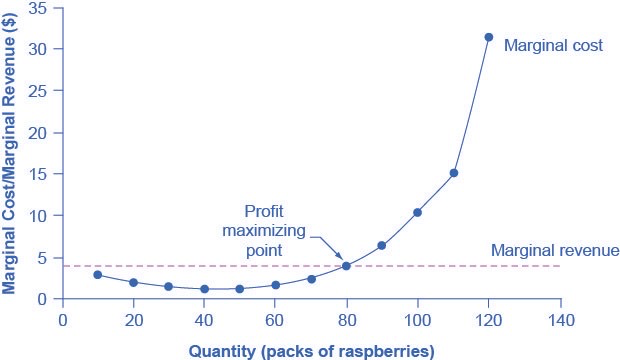Marginal Revenue Curve
What is the Marginal Revenue Curve?
- Marketing, Advertising, Sales & PR
- Accounting, Taxation, and Reporting
- Professionalism & Career Development
-
Law, Transactions, & Risk Management
Government, Legal System, Administrative Law, & Constitutional Law Legal Disputes - Civil & Criminal Law Agency Law HR, Employment, Labor, & Discrimination Business Entities, Corporate Governance & Ownership Business Transactions, Antitrust, & Securities Law Real Estate, Personal, & Intellectual Property Commercial Law: Contract, Payments, Security Interests, & Bankruptcy Consumer Protection Insurance & Risk Management Immigration Law Environmental Protection Law Inheritance, Estates, and Trusts
- Business Management & Operations
- Economics, Finance, & Analytics
What is the Marginal Revenue Curve?
The marginal revenue curve shows the additional revenue gained from selling one more unit. As mentioned before, a firm in perfect competition faces a perfectly elastic demand curve for its product—that is, the firm’s demand curve is a horizontal line drawn at the market price level. This also means that the firm’s marginal revenue curve is the same as the firm’s demand curve: Every time a consumer demands one more unit, the firm sells one more unit and revenue increases by exactly the same amount equal to the market price.
This condition only holds for price taking firms in perfect competition where:
marginal revenue = price
Under perfect competition, marginal revenue does not change as the firm produces more output. That is because under perfect competition, the price is determined through the interaction of supply and demand in the market and does not change as the farmer produces more (keeping in mind that, due to the relative small size of each firm, increasing their supply has no impact on the total market supply where price is determined).
Since a perfectly competitive firm is a price taker, it can sell whatever quantity it wishes at the market-determined price. We calculate marginal cost, the cost per additional unit sold, by dividing the change in total cost by the change in quantity.
Ordinarily, marginal cost changes as the firm produces a greater quantity. At some point, though, marginal costs start to increase, displaying the typical pattern of diminishing marginal returns. If the firm is producing at a quantity where MR > MC then it can increase profit by increasing output because the marginal revenue is exceeding the marginal cost. If the firm is producing at a quantity where MC > MR then it can increase profit by reducing output because the reductions in marginal cost will exceed the reductions in marginal revenue. The firm’s profit-maximizing choice of output will occur where MR = MC (or at a choice close to that point).

The profit-maximizing choice for a perfectly competitive firm will occur at the level of output where marginal revenue is equal to marginal cost—that is, where MR = MC.
Because the marginal revenue received by a perfectly competitive firm is equal to the price P, we can also write the profit-maximizing rule for a perfectly competitive firm as a recommendation to produce at the quantity of output where P = MC.
Related Topics
- Market Structure
- Perfect Competition
- Bidding War
- Complements & Substitutes
- Substitution Effect
- Imperfect Competition
- Market Power
- Price Takers
- Price Makers
- Perfect Competition and Decision Making
- X-Efficiency
- Captive Market
- Contestable Market Theory
- Highest Profit Point in a Perfectly Competitive Market
- Marginal Revenue
- Using Marginal Revenue and Marginal Costs to Maximize Profit
- Marginal Revenue Curve
- Profit Margin and Average Total Cost
- Break Even Point - Cost Curve
- Shutdown Point - Cost Curve
- Short-Run Decisions Based Upon Costs in a Perfectly Competitive Market
- Marginal Costs and the Supply Curve for a Perfectively Competitive Firm
- Long-Run Average Supply (LRAS)
- Decisions to Enter or Exit a Market in the Long Run
- Long-Run Equilibrium in a Perfectly Competitive Market
- Constant, Increasing, and Decreasing Cost Industries
- Productive and Allocative Efficiency in Perfectly Competitive Markets
- Market Efficiency
- Market Inefficiency
- Pareto Efficiency
- Market Failure
- Search Theory
- Monopoly
- Natural Monopoly
- Legal Monopoly
- Bilateral Monopoly
- Promoting Innovation through Intellectual Property
- Predatory Pricing
- How Monopolists Set Price with the Demand Curve
- Total Cost and Total Revenue for a Monopolist
- Marginal Revenue and Marginal Cost for a Monopolist
- Inefficiency of Monopoly
- Perfectly Competitive Market
- Monopolistic Competition
- Duopoly
- Oligopoly
- Differentiated Products
- Perceived Demand for a Monopolistic Competitor
- Monopolistic Competitors Choose Price and Quantity
- Monopolistic Competitors and Entry
- Monopolistic Competition and Efficiency
- Cartel (Economics)
- Game Theory
- Traveler's Dilemma
- Prisoner's Dilemma
- Iterated Prisoner's Dilemma
- Nash Equilibrium
- Diner's Dilemma
- Trembling Hand Perfect Equilibrium
- Gambler's Fallacy
- Arrows Impossibility Theorem
- Backward Induction
- Tournament Theory
- Oligopoly and the Prisoner’s Dilemma
- Forcing Cooperation in a Prisoner’s Dilemma
- Cooperation and the Kinked Demand Curve
- Corporate Merger or Acquisition
- Antitrust Laws
- Herfindahl-Hirschman Index
- Concentration Ratio
- Other Approaches to Measuring Monopoly Power in an Industry
- Restrictive Practices under Antitrust Law
- Natural Monopoly
- Cost-Plus Regulation
- Price Cap Regulation
- Regulatory Capture